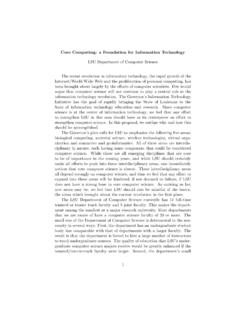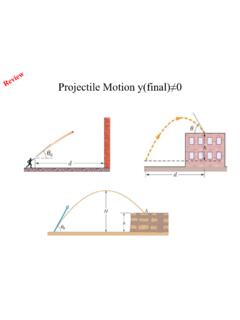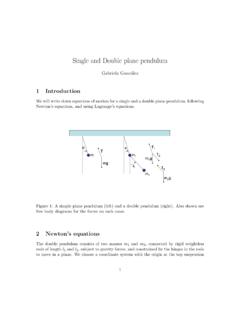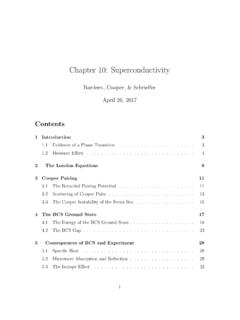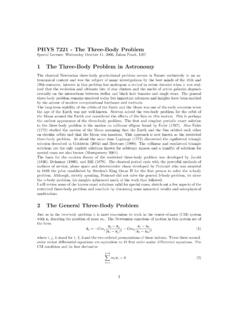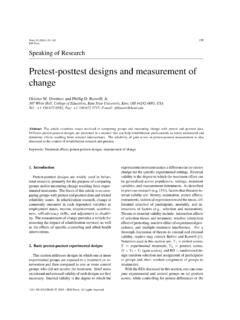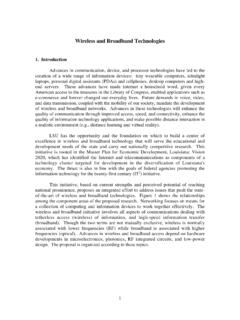Transcription of -2 Newton's Law of Gravitation
1 PROBLEMS. sec. 13-2 Newton's Law of Gravitation 1 A mass M is split into two parts, m and M m, which are then separated by a certain distance. What ratio m/M maximizes the magnitude of the gravitational force between the parts? Answer: 2 Moon effect. Some people believe that the Moon controls their activities. If the Moon moves from being directly on the opposite side of Earth from you to being directly overhead, by what percent does (a) the Moon's gravitational pull on you increase and (b) your weight (as measured on a scale) decrease? Assume that the Earth Moon (center-to-center) distance is . 108 m and Earth's radius is 106 m. 3 What must the separation be between a kg particle and a kg particle for their gravitational attraction to have a magnitude of 10-12 N? Answer: 19 m 4 The Sun and Earth each exert a gravitational force on the Moon.
2 What is the ratio FSun/FEarth of these two forces? (The average Sun Moon distance is equal to the Sun Earth distance.). sec. 13-3 Gravitation and the Principle of Superposition 5 Miniature black holes. Left over from the big-bang beginning of the universe, tiny black holes might still wander through the universe. If one with a mass of 1 1011 kg (and a radius of only 1 . 10-16 m) reached Earth, at what distance from your head would its gravitational pull on you match that of Earth's? Answer: m 6 In Fig. 13-31, a square of edge length cm is formed by four spheres of masses m1 = g, m2 = g, m3 = g, and m4 = g. In unit-vector notation, what is the net gravitational force from them on a central sphere with mass m5 = g? Figure 13-31 Problem 6. 7 One dimension. In Fig. 13-32, two point particles are fixed on an x axis separated by distance d.
3 Particle A has mass mA and particle B has mass A third particle C, of mass , is to be placed on the x axis and near particles A and B. In terms of distance d, at what x coordinate should C be placed so that the net gravitational force on particle A from particles B and C is zero? Figure 13-32 Problem 7. Answer: 8In Fig. 13-33, three kg spheres are located at distances d1 = m and d2 = m. What are the (a) magnitude and (b) direction (relative to the positive direction of the x axis) of the net gravitational force on sphere B due to spheres A and C? Figure 13-33 Problem 8. 9 We want to position a space probe along a line that extends directly toward the Sun in order to monitor solar flares. How far from Earth's center is the point on the line where the Sun's gravitational pull on the probe balances Earth's pull? Answer: 105 km 10 Two dimensions.
4 In Fig. 13-34, three point particles are fixed in place in an xy plane. Particle A has mass mA, particle B has mass , and particle C has mass A fourth particle D, with mass , is to be placed near the other three particles. In terms of distance d, at what (a). x coordinate and (b) y coordinate should particle D be placed so that the net gravitational force on particle A from particles B, C, and D is zero? Figure 13-34 Problem 10. 11As seen in Fig. 13-35, two spheres of mass m and a third sphere of mass M form an equilateral triangle, and a fourth sphere of mass m4 is at the center of the triangle. The net gravitational force on that central sphere from the three other spheres is zero. (a) What is M in terms of m? (b) If we double the value of m4, what then is the magnitude of the net gravitational force on the central sphere? Figure 13-35 Problem 11.
5 Answer: (a) M = m; (b) 0. 12In Fig. 13-36a, particle A is fixed in place at x = m on the x axis and particle B, with a mass of kg, is fixed in place at the origin. Particle C (not shown) can be moved along the x axis, between particle B and x = . Figure 13-36b shows the x component of the net gravitational force on particle B due to particles A and C, as a function of position x of particle C. The plot actually extends to the right, approaching an asymptote of 10-10 N as x . What are the masses of (a) particle A and (b) particle C? Figure 13-36 Problem 12. 13 Figure 13-37 shows a spherical hollow inside a lead sphere of radius R = cm; the surface of the hollow passes through the center of the sphere and touches the right side of the sphere. The mass of the sphere before hollowing was M = kg. With what gravitational force does the hollowed-out lead sphere attract a small sphere of mass m = kg that lies at a distance d =.
6 Cm from the center of the lead sphere, on the straight line connecting the centers of the spheres and of the hollow? Figure 13-37 Problem 13. Answer: 10-9 N. 14 Three point particles are fixed in position in an xy plane. Two of them, particle A of mass g and particle B of mass g, are shown in Fig. 13-38, with a separation of dAB = m at angle = 30 . Particle C, with mass g, is not shown. The net gravitational force acting on particle A due to particles B and C is 10-14 N at an angle of from the positive direction of the x axis. What are (a) the x coordinate and (b) the y coordinate of particle C? Figure 13-38 Problem 14. 15 Three dimensions. Three point particles are fixed in place in an xyz coordinate system. Particle A, at the origin, has mass mA. Particle B, at xyz coordinates ( , , ), has mass , and particle C, at coordinates ( , , ), has mass A fourth particle D, with mass , is to be placed near the other particles.
7 In terms of distance d, at what (a) x, (b) y, and (c) z coordinate should D be placed so that the net gravitational force on A from B, C, and D. is zero? Answer: (a) ; (b) ; (c) 16In Fig. 13-39, a particle of mass m1 = kg is a distance d = 23 cm from one end of a uniform rod with length L = m and mass M = kg. What is the magnitude of the gravitational force on the particle from the rod? Figure 13-39 Problem 16. sec. 13-4 Gravitation Near Earth's Surface 17(a) What will an object weigh on the Moon's surface if it weighs 100 N on Earth's surface? (b). How many Earth radii must this same object be from the center of Earth if it is to weigh the same as it does on the Moon? Answer: (a) 17 N; (b) 18 Mountain pull. A large mountain can slightly affect the direction of down as determined by a plumb line. Assume that we can model a mountain as a sphere of radius R = km and density (mass per unit volume) 103 kg/m3.
8 Assume also that we hang a m plumb line at a distance of 3R from the sphere's center and such that the sphere pulls horizontally on the lower end. How far would the lower end move toward the sphere? 19 At what altitude above Earth's surface would the gravitational acceleration be m/s2? Answer: 106 m 20 Mile-high building. In 1956, Frank Lloyd Wright proposed the construction of a mile-high building in Chicago. Suppose the building had been constructed. Ignoring Earth's rotation, find the change in your weight if you were to ride an elevator from the street level, where you weigh 600. N, to the top of the building. 21 Certain neutron stars (extremely dense stars) are believed to be rotating at about 1 rev/s. If such a star has a radius of 20 km, what must be its minimum mass so that material on its surface remains in place during the rapid rotation?
9 Answer: 5 1024 kg 22 The radius Rh and mass Mh of a black hole are related by Rh = 2 GMh/c2, where c is the speed of light. Assume that the gravitational acceleration ag of an object at a distance ro = from the center of a black hole is given by Eq. 13-11 (it is, for large black holes). (a) In terms of Mh, find ag at ro. (b) Does ag at ro increase or decrease as Mh increases? (c) What is ag at ro for a very large black hole whose mass is 1012 times the solar mass of 1030 kg? (d) If an astronaut of height m is at ro with her feet down, what is the difference in gravitational acceleration between her head and feet? (e) Is the tendency to stretch the astronaut severe? 23 One model for a certain planet has a core of radius R and mass M surrounded by an outer shell of inner radius R, outer radius 2R, and mass 4M. If M = 1024 kg and R = 106 m, what is the gravitational acceleration of a particle at points (a) R and (b) 3R from the center of the planet?
10 Answer: (a) m/s2; (b) m/s2. sec. 13-5 Gravitation Inside Earth 24 Two concentric spherical shells with uniformly distributed masses M1 and M2 are situated as shown in Fig. 13-40. Find the magnitude of the net gravitational force on a particle of mass m, due to the shells, when the particle is located at radial distance (a) a, (b) b, and (c) c. Figure 13-40 Problem 24. 4. 25A solid uniform sphere has a mass of 10 kg and a radius of m. What is the magnitude of the gravitational force due to the sphere on a particle of mass m located at a distance of (a) m and (b) m from the center of the sphere? (c) Write a general expression for the magnitude of the gravitational force on the particle at a distance r m from the center of the sphere. Answer: (a) ( 10-7 N/kg)m; (b) ( 10-7 N/kg)m; (c) ( 10-7 N/kg m)mr 26 Consider a pulsar, a collapsed star of extremely high density, with a mass M equal to that of the Sun ( 1030 kg), a radius R of only 12 km, and a rotational period T of s.


